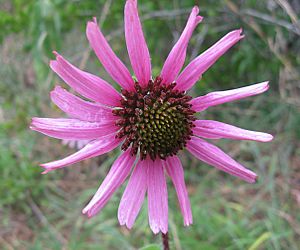Tennessee coneflower facts for kids
Quick facts for kids Tennessee coneflower |
|
|---|---|
 |
|
| Conservation status | |
| Scientific classification | |
| Genus: |
Echinacea
|
| Species: |
tennesseensis
|
| Synonyms | |
|
|
The Tennessee coneflower (Echinacea tennesseensis) is a special kind of flowering plant. It is also called the Tennessee purple coneflower. This plant belongs to the sunflower family. It grows only in a specific area of central Tennessee, in places called cedar glades.
About the Tennessee Coneflower
The Tennessee coneflower is a perennial plant. This means it lives for more than two years. It grows back each year from its roots. It can reach about 75 centimeters (2.5 feet) tall.
Its leaves are covered in small hairs. They are shaped like a spear, which is called lanceolate. Most of the leaves grow in a circle near the ground. The flower stems have only a few small leaves.
The plant's flowers grow in a special cluster called a flowerhead. This flowerhead can be up to 8 centimeters (3.2 inches) wide. It has purple petals, called ray florets, around the outside. In the center are many small brown disc florets.
One cool thing about this coneflower is how its petals stand up straight. Other similar coneflower types, like Echinacea angustifolia and Echinacea purpurea, usually have petals that droop downwards.
Where It Lives
The Tennessee coneflower is a very rare plant. You can find it in fewer than 10 spots. These spots are in Davidson, Wilson, and Rutherford Counties in Tennessee.
Scientists think this plant's ancestors spread into Tennessee a long time ago. This was after the last ice age. At that time, the weather was drier. Prairies, which are like grasslands, covered much of the central U.S.
Later, the weather became wetter. Forests grew where the prairies once were. The coneflower plants became separated in the cedar glades. These glades were like small islands of prairie surrounded by forests. This separation caused the Tennessee coneflower to become its own unique species.
Protecting the Tennessee Coneflower
The Tennessee coneflower was once listed as an endangered plant. This meant it was at risk of disappearing forever. Groups like the Nature Conservancy and the State of Tennessee helped protect it. They bought land where the plant grows to keep its habitat safe.
The United States Fish and Wildlife Service decided the plant was no longer in danger. This was because the threats to its survival were gone or much smaller. So, on September 2, 2011, the Tennessee coneflower was removed from the endangered species list. This was a big success for plant conservation!



